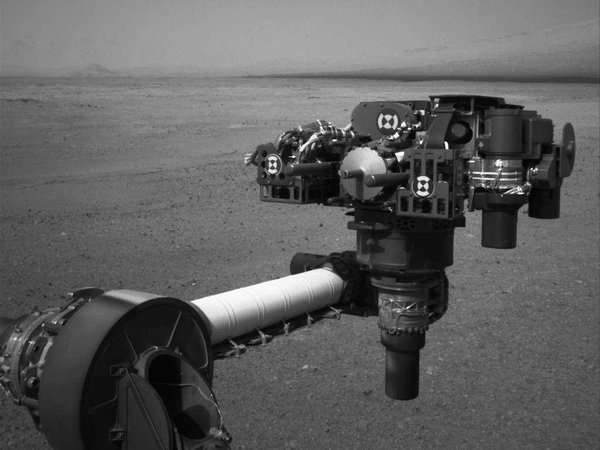More than two weeks after landing in Mars' Gale Crater, NASA's Curiosity rover has wiggled its wheels to warm up for its first honest-to-goodness drive, just hours from now.
Mission manager Mike Watkins said that the wiggle tests, which involved twisting the rover's four turnable wheels to the left and to the right in place, were done successfully overnight.
"We wanted to test the steering, because otherwise we would be driving in whatever direction we landed in," Watkins explained today during a teleconference that originated from NASA's Jet Propulsion Laboratory in Pasadena, Calif. "Everything's in fine shape, and that means we are 'go' for our first test drive tomorrow."
Watkins said the commands will be sent up tonight for a drive of just a few yards (meters), incorporating a turn to the right and a backing-up maneuver. That initial movement should occur "in the middle of the night our time" and last about a half-hour, he said.
The six-wheeled rover has a versatile steering system, with two front and two rear wheels that can be independently twisted so much that the car-sized, 1-ton vehicle pirouettes in place. The two middle wheels can push as well, but they aren't built for turning. Each wheel measures 20 inches (50 centimeters) in diameter, which is comparable to the size of an automotive tire.
Successful driving is the key to Curiosity's two-year, $2.5 billion mission, because its ultimate goal is to reach the flanks of a 3-mile-high mountain within the crater, known as Aeolis Mons or Mount Sharp. That target is about 12.5 miles (20 kilometers) away, Watkins said. Once the rover is fully into its drive mode, it's expected to trek up to the length of a football field (100 meters) in a day.
Curiosity's first destination is an intersection of three geological formations about a quarter-mile (400 meters) from the landing site, known as Glenelg. The rover is scheduled to spend the next couple of months trekking to that area, and then turn its wheels toward Mount Sharp. That's where scientists expect to read the geological history of Mars over the course of billions of years, as recorded in the layers of rock going up the mountainside. Those readings could show how habitable the planet might have been at different epochs.
NASA has scheduled a televised briefing at 2:30 p.m. ET (11:30 a.m. PT) Wednesday, presumably to share the results of the first driving commands.
Instruments checked out
Watkins said the Curiosity team has been doing checkouts on the rover's 7-foot-long (2.1-meter-long) robotic arm as well as the 10 scientific instruments on board. "We've gotten through all of those successfully and on schedule," he said.

JPL's Louise Jandura, the mission's sample system chief, said the first tests to flex the robotic arm were successful, but additional tests will be done over the next few weeks to make sure the arm motions are fine-tuned for Martian gravity. The turret at the end of the arm weighs 66 pounds (30 kilograms), or as much as a small child, so the mechanics of moving the arm will be different on the Red Planet than they were during testing on Earth. The gravitational pull on the Martian surface is only 38 percent of what it is on Earth.
"That gravity does matter," Jandura said.
Only one significant snag has been discovered to date, said Ashwin Vasavada, the mission's deputy project scientist. Two of the three circuit boards on one of the booms for the rover's weather station - known formally as the Rover Environmental Monitoring Station, or REMS - are out of action, apparently due to some broken wires, he said.
Vasavada speculated that the exposed boards were hit by small rocks that were thrown up onto the rover's deck when it was lowered to the surface by a rocket-powered sky crane. "Putting two and two together, you could come up with an idea that some of these rocks may have fallen on the circuit boards and damaged the wires," he told reporters.
If the circuitry is permanently damaged, that would degrade the boom's wind-sensing capability, Vasavada said. However, the circuit boards on a second wind-sensing boom appear to be fine, so it's not a total loss wind-wise. The REMS station is already sending back weather reports indicating that the conditions are typical for the late winter and early spring on Mars, with temperatures rising just above the freezing mark.
More rocks zapped
Vasavada also said the rover's laser-zapping ChemCam system is "working better than we hoped," based on the results of the past weekend's test firing. The laser took 30 quick target-practice shots at a 3-inch-wide (7.5-centimeter-wide) rock that was nicknamed "Coronation," and also known as N165. The tiny flashes given off by the rock blasts were analyzed by a spectrometer on the rover to determine the mineral composition of the rock.
"It appears to be, as we thought, a typical Martian basalt," Vasavada said.
He said ChemCam took some additional test shots at rocks in one of the sky-crane blast zones, known as Goulburn Scour, but Vasavada said the results of those tests were not yet available.
Tests are also going well for an instrument that detects hydrogen by shooting neutrons at the ground, said Igor Mitrofanov, principal investigator for the Dynamic Albedo of Neutrons experiment, or DAN. The readings show a pattern suggesting that Mars is "really a different" place from Earth.
Back in 2008, NASA's Mars Phoenix Lander detected water ice right under the spacecraft, but Mitrofanov said "we have not predicted any subsurface ice here," in the vicinity of the Curiosity rover. Rather, the team expects to find the signature of hydrated minerals, which would suggest that water flowed through Gale Crater in ancient times.



Reader Comments
to our Newsletter